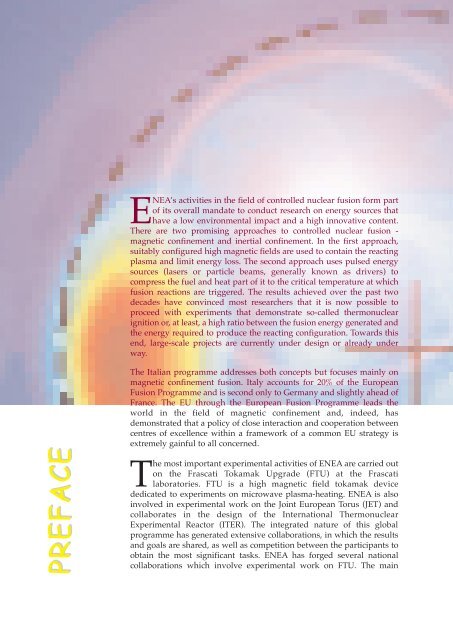1. magnetic confinement - ENEA - Fusione
1. magnetic confinement - ENEA - Fusione
1. magnetic confinement - ENEA - Fusione
You also want an ePaper? Increase the reach of your titles
YUMPU automatically turns print PDFs into web optimized ePapers that Google loves.
<strong>ENEA</strong>’s activities in the field of controlled nuclear fusion form part<br />
of its overall mandate to conduct research on energy sources that<br />
have a low environmental impact and a high innovative content.<br />
There are two promising approaches to controlled nuclear fusion -<br />
<strong>magnetic</strong> <strong>confinement</strong> and inertial <strong>confinement</strong>. In the first approach,<br />
suitably configured high <strong>magnetic</strong> fields are used to contain the reacting<br />
plasma and limit energy loss. The second approach uses pulsed energy<br />
sources (lasers or particle beams, generally known as drivers) to<br />
compress the fuel and heat part of it to the critical temperature at which<br />
fusion reactions are triggered. The results achieved over the past two<br />
decades have convinced most researchers that it is now possible to<br />
proceed with experiments that demonstrate so-called thermonuclear<br />
ignition or, at least, a high ratio between the fusion energy generated and<br />
the energy required to produce the reacting configuration. Towards this<br />
end, large-scale projects are currently under design or already under<br />
way.<br />
PREFACE<br />
The Italian programme addresses both concepts but focuses mainly on<br />
<strong>magnetic</strong> <strong>confinement</strong> fusion. Italy accounts for 20% of the European<br />
Fusion Programme and is second only to Germany and slightly ahead of<br />
France. The EU through the European Fusion Programme leads the<br />
world in the field of <strong>magnetic</strong> <strong>confinement</strong> and, indeed, has<br />
demonstrated that a policy of close interaction and cooperation between<br />
centres of excellence within a framework of a common EU strategy is<br />
extremely gainful to all concerned.<br />
The most important experimental activities of <strong>ENEA</strong> are carried out<br />
on the Frascati Tokamak Upgrade (FTU) at the Frascati<br />
laboratories. FTU is a high <strong>magnetic</strong> field tokamak device<br />
dedicated to experiments on microwave plasma-heating. <strong>ENEA</strong> is also<br />
involved in experimental work on the Joint European Torus (JET) and<br />
collaborates in the design of the International Thermonuclear<br />
Experimental Reactor (ITER). The integrated nature of this global<br />
programme has generated extensive collaborations, in which the results<br />
and goals are shared, as well as competition between the participants to<br />
obtain the most significant tasks. <strong>ENEA</strong> has forged several national<br />
collaborations which involve experimental work on FTU. The main













